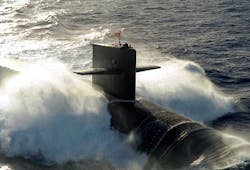Lockheed Martin to move Trident nuclear missile design to next-generation ballistic missile submarine
Officials of the Navy Strategic Systems Programs office in Washington are awarding a potential $99.2 million contract to Lockheed Martin Corp. to integrate the Trident II onto the next-generation ballistic submarine designs of the U.S. and United Kingdom.
Experts at the Lockheed Martin Space Systems segment in Sunnyvale, Calif., are integrating the Trident II missile and reentry strategic weapon system subsystems into the common missile compartment for the Ohio replacement and United Kingdom successor programs.
The Ohio replacement is being designed to replace the Navy's fleet of Ohio-class ballistic missile submarines -- each of which patrol the world's oceans carrying as many as 24 Trident II missiles as part of the U.S. nuclear deterrent triad that consists of ballistic missile submarines, nuclear bombers, and land-based intercontinental ballistic missiles. The United Kingdom successor program, meanwhile, will replace the Royal Navy's fleet of Vanguard-class ballistic missile submarines.
The U.S. Navy today operates 18 Ohio-class submarines -- 14 of which carry the Trident nuclear missile, and four of which have been modified to carry conventionally armed long-range cruise missiles. Lockheed Martin is prime contractor for the Trident II missile.
Construction of the Ohio-class submarines began in 1976, and the submarines have been in commission at sea since 1981. Construction of Ohio-class submarines ceased in 1997 and submarines of the class are scheduled to be decommissioned and replaced starting in 2029.
The United Kingdom Vanguard-class ballistic missile submarine has been at sea since 1993. The Royal Navy operates four Vanguard-class subs.
Construction of the new Ohio replacement is scheduled to begin in 2021, and the first boat of the class should be commissioned and deployed at sea in 2031.
The contract to Lockheed Martin calls for the company to provide engineering and support for integrating the Trident II missile and reentry system subsystems into the common missile compartment for the Ohio replacement and United Kingdom successor programs; gas dynamic testing and high fidelity aft end fabrication for nozzle shield retention testing; program management of an integrated test facility that will be compatible with existing and new submarine fleets; and manufacture, test and delivery of missile service units.
Related: Navy invests in submarine-launched nuclear ballistic missile guidance upgrades and test
Three months ago Lockheed Martin won a potential $828.4 million Navy contract modification to provide the Navy with new Trident II D5 missiles and Trident missile upgrades.
The Ohio replacement submarine, yet unnamed, will be 560 feet long -- the same length as the Ohio-class submarines -- and will have 16 missile tubes -- eight fewer missile tubes than the Ohio class. Plans now call for building 12 Ohio replacement submarines.
Each Ohio replacement boat will displace more than 20,000 tons, cost about $5 billion to build, and cost about $110 million each year to operate. Building the new submarines will be General Dynamics Electric Boat in Groton, Conn.
Related: Nuclear ballistic missile technology remains a post-Cold-War defense priority
The Ohio replacement design effort will borrow from developments in the Virginia- and Seawolf-class attack submarines. Innovations planned for the Ohio replacement include an new electric propulsion system nuclear reactor to reduce maintenance time and costs.
On the contract to Lockheed Martin awarded late last month, the company will do the work in Cape Canaveral, Fla.; Sunnyvale, Calif.; Rialto, Calif.; Magna, Utah; Cincinnati; Merritt Island, Fla.; and other locations, and should be finished by the end of 2017. If options are exercised, work will continue through September 2020.
For more information contact Lockheed Martin Space Systems online at www.lockheedmartin.com/us/ssc, or the Navy Strategic Systems Program office at www.ssp.navy.mil.
